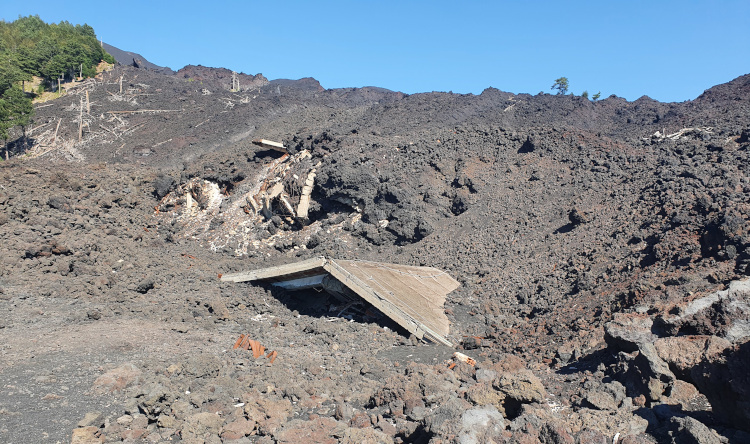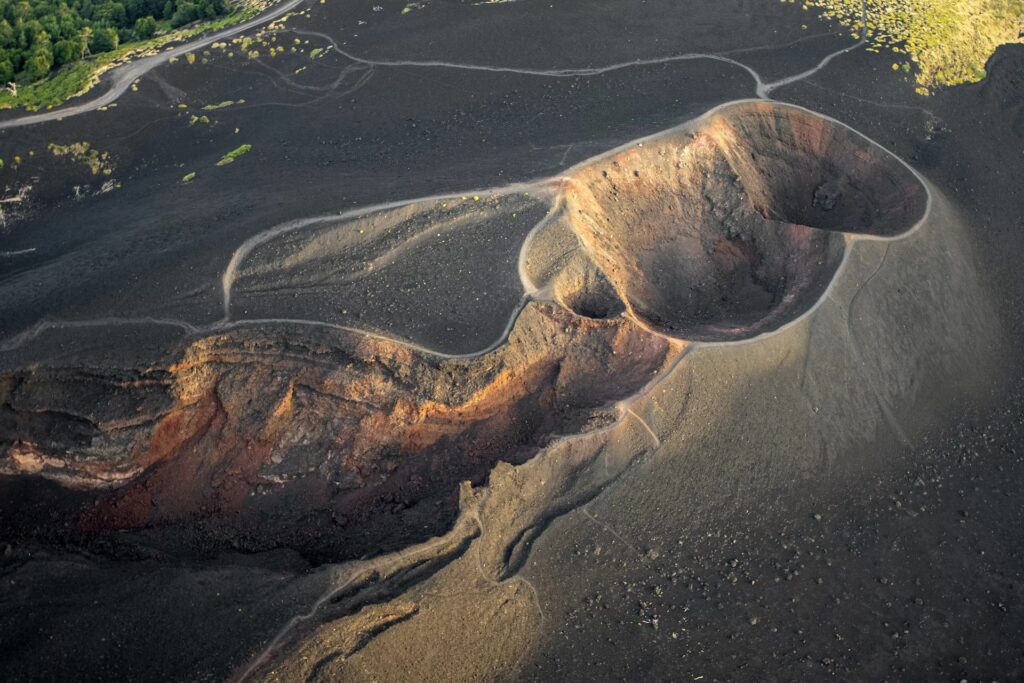In this article, we tell you about the 2002 eruption, an extraordinary event in which two eruptive systems are active at the same time, one on the south side and one on the north side of Etna.
A little more than a year has passed since the spectacular eruption of 2001 and on 26 October 2002, the spectacle begins again.
During the evening, some seismic swarms occur in the area of the summit craters and on the northeastern side, damaging the structures near the ski resorts of Etna North. A few hours later, on the south side of Etna, south of the Torre del Filosofo (“Philosopher’s Tower”) refuge, two gorges open at an altitude of 2750 metres. 100 to 200 m high lava fountains signal the start of a new eruption.
In the early hours of the morning, another mouth opens a little further down and almost simultaneously a long series of fractures opens on the north side, exactly along the Pernicana Fault or also called the Northeast Rift.
An extraordinary event, more than 5 km apart two eruptive systems are active, one on the south side and one on the north side, incredibly, it seems that “a Muntagna” is literally splitting in two.
Activity on the north side
On the north side, a series of fractures is distributed along a line of impressive proportions, between 2050 and 2470 metres in altitude, over a length of about three kilometres. Shortly after 4:00 am, we can count up to 25 plumes of smoke coming from the ridge west of Piano Provenzana between more or less large mouths. A fissure in the ground of this size, formed exactly on the northeastern fault, forms a very easy exit path for the lava, which consequently moved very quickly.
The first lava flows branch off from a lava overflow about halfway up the fault line at 2350 m, cross the ski slopes and reach the tourist centre of Etna North. Even from the lowest part of the fracture, a lava flow of impressive proportions emerges. The lava flows branch off in different directions, but among the many, unfortunately, the one that finds the best path and therefore makes faster progress is the one that flows towards Piano Provenzana, and so in just 10 hours the Hotel Le Betulle and dozens of souvenir shops are washed away.

This is all that remains of the 2-storey Hotel Le Betulle today.
The men of the Civil Defence can only watch helplessly as the lava flow advances inexorably, devouring everything it encounters; they can only contain the various fires that develop in the Ragabo pine forest (Pineta Ragabo), which will have lost 250 hectares of Etna larch pines (Pinus Nigra Larix) by the end of the eruption.

In the picture above you can see the lava flow that destroyed the entire tourist centre of Piano Provenzana in 2002. The new centre was later rebuilt on the lava flow.
During the activity, we are already beginning to delineate what will be called the 2002 button line, a fantastic series of craters aligned on the northeast rift – or Pernicana fault -, which predominantly fit into the many buttonholes that have formed on this troubled slope over the centuries.
The activity continues at a remarkable rate for 10 days, about one kilometre per day, which worried the population of the town of Linguaglossa; some dams were built to try to slow down the advance of the lava, but without much success. Another one was built at 1100 m and it was hoped that it could save the city by diverting the lava flow towards the northwest.
On 7 November, however, the lava stops its advance about fifty metres in front of the newly built artificial dam, sparing all the fields and gardens behind it and the settlement areas about 5 kilometres away.
Activity on the south side
On the southern slope, not only are the lava fountains a spectacle, but there is also explosive phreatomagmatic activity (the lava comes into contact with water, which suddenly heats up and thus multiplies its volume). The ash columns rise towards the sky in the following days and are carried on by the winds. The first lava flows begin to form and continue south towards Monte Nero degli Zappini.
Earthquake of 29 October 2002 or Santa Venerina earthquake
On the morning of 29 October, in addition to the ongoing eruptions on both sides, 51 seismic events occur. The strongest of them, with a magnitude of 4.4 on the Richter scale, has its epicentre in Santa Venerina, where it caused extensive damage. The towns of Zafferana Etnea, Milo, Sant’Alfio, Acireale are also within his sphere of influence. Fortunately, there are no victims. Civil Defence is working to address the emergency, setting up tent camps and securing unsafe structures.
29 October is not a good day for the population of much of eastern Sicily. It seems as if Etna wants to bury Catania and part of the Mediterranean. The ash column rises about 12 km high, the high altitude winds from the north carry it southwards, towards Catania, Malta, the Greek islands and the coast of Libya.
Etna villages and Catania are struggling with a rain of ash covering everything from the roofs of houses to vegetable crops, from roads to beaches. The damage in agriculture is great, but the situation is not easy in the city either. The ash covers everything, clogs manholes and gutters, the roads are badly affected because the sand makes the road slippery. The population is forced to use umbrellas, hats, masks to cover nose and mouth, Catania airport is closed and air traffic is suspended or diverted throughout the area, it seems like an apocalypse.
In the following days the ash production starts to decrease significantly, on 31 October the winds start to carry the ash to the north-east, leading to the closure of Reggio Calabria airport.
For about 10 days, the explosive activity of the two eruptions continues at an altitude of 2750 m, but the lava flows begin to slow down.
On 12 November, ash emission slows down and the explosive activity becomes mainly strombolian type activity.
On 13 November, an increase in volcanic tremor announces the formation of a new eruptive vent at the base of the cinder cone at an altitude of 2700 m, which gives rise to a new lava flow.
On 15 November, an ephemeral mouth opens to further feed the flow, which reaches an altitude of 2180 m, but ash emission still emanates from the mouth at 2750 m.
On 21 November, another maw opened, causing fears of the worst for the heart of the Etna South tourist centre, so that the intervention of the army was requested. In collaboration with some private companies, dams were built, like the banks of a riverbed but in this case made of lava, to protect the buildings that were spared from the 2001 eruption: the Rifugio Sapienza, the cable car station and the service centre of the municipality of Nicolosi.
At 23. and 24 November, further seismic swarms were recorded around the eruptive area and two mouths that had formed at the beginning of the eruption and then ceased their activity were reactivated. The lava front reaches a height of 1900 m.
At the end of November, the flow descends to an altitude of 1800 m and, running in the middle of vegetation, causes several fires.
In December, the flows move slowly forward until the 10th day, while the emission of ash from the crater continues at an altitude of 2750 metres. At its base, two effusive mouths open and form a new stream. Meanwhile, the crater’s strombolian activity continues at 2800 metres.
On 12 December, the lava flows reach the end of the ski slopes near the Sapienza hut.
On the night of 16 December, the lava steps over the slope and destroys the Nicolosi service centre and the Esagonal restaurant.
Subsequently, the ash explosions from the crater at 2750 m and the effusive activity still continued, but slowly everything came to an end within a month and a half, until 29 January 2003.
The emission of lava ash and lapilli from this eruption is estimated at about 160 million cubic metres. The craters formed on the southern side are called Barbagallo craters. Today they are just under 3000 metres high. Unfortunately, the famous Torre del Filosofo refuge has also paid dearly for the formation of these new Barbagallo craters. It is completely buried by rubble and only a small part of the antenna remains visible, at least for a few more years.
But that is another story…


